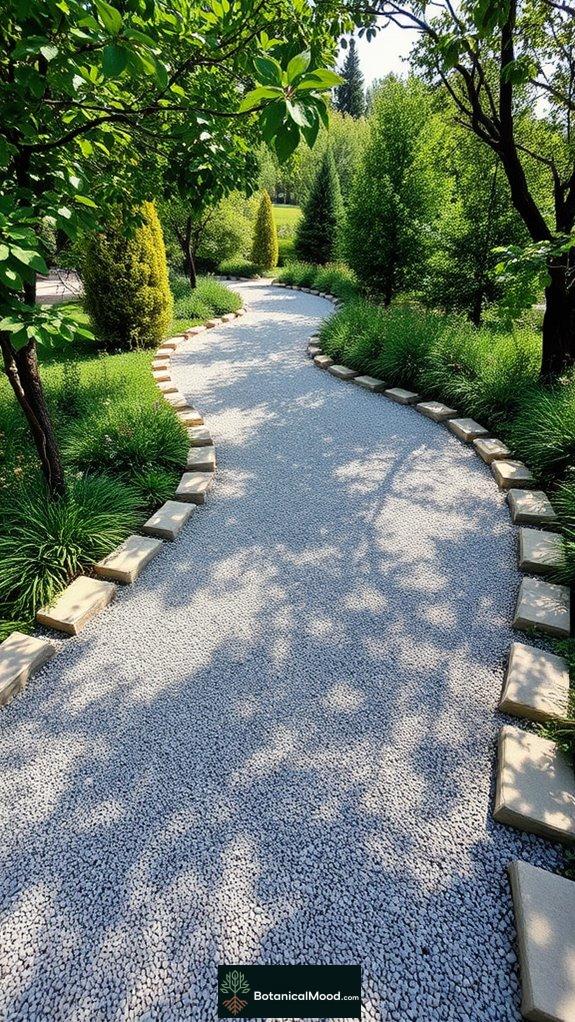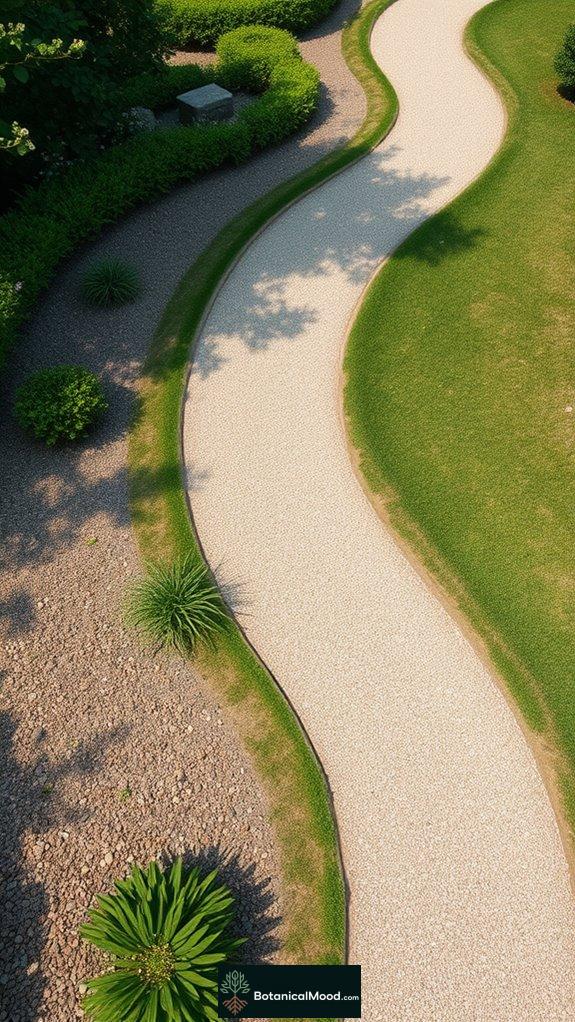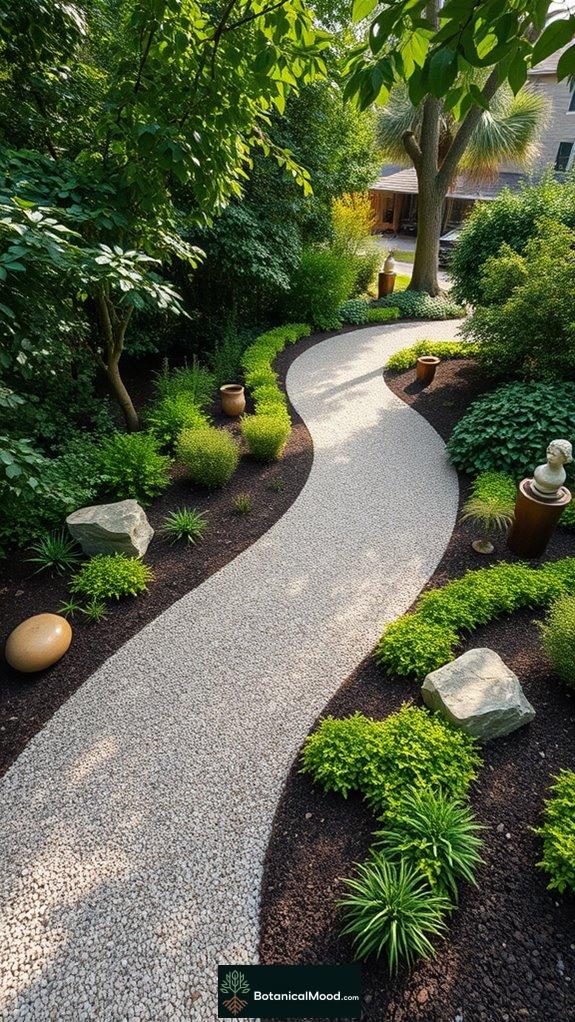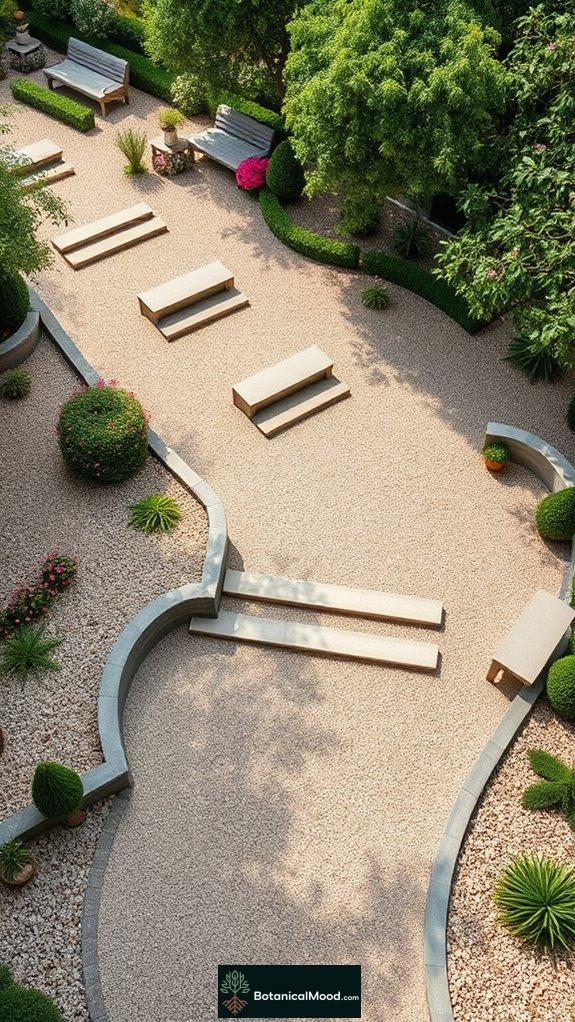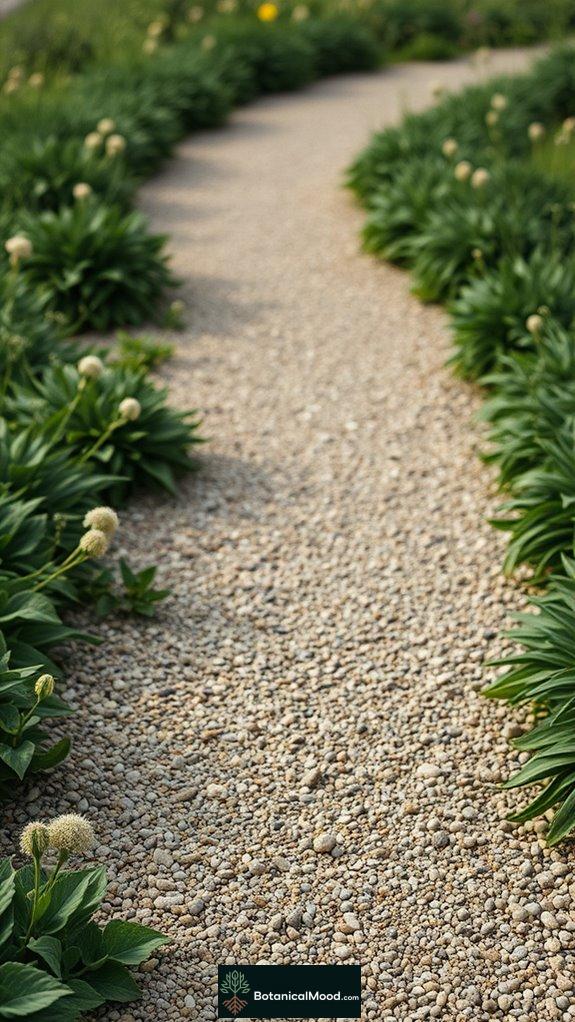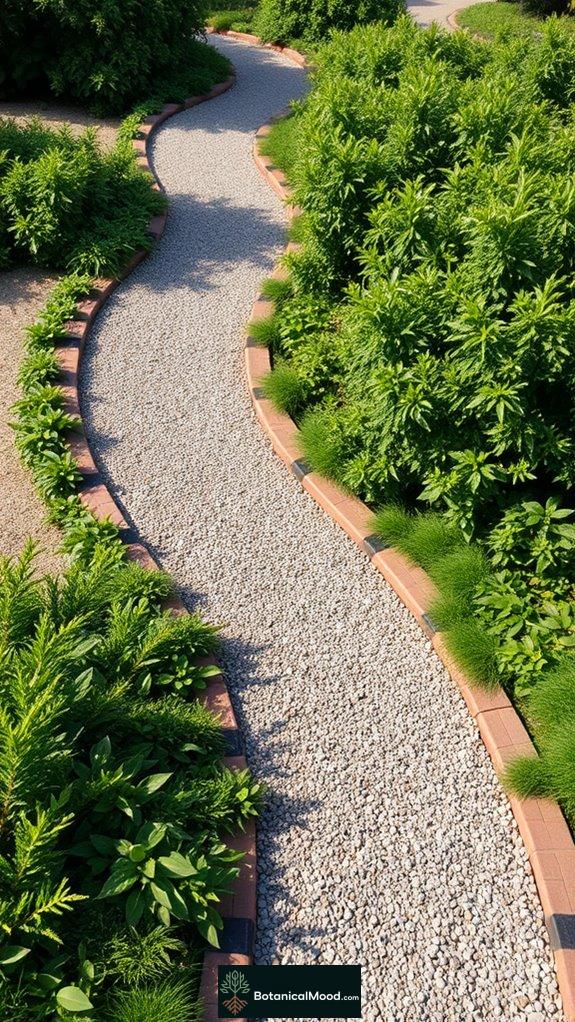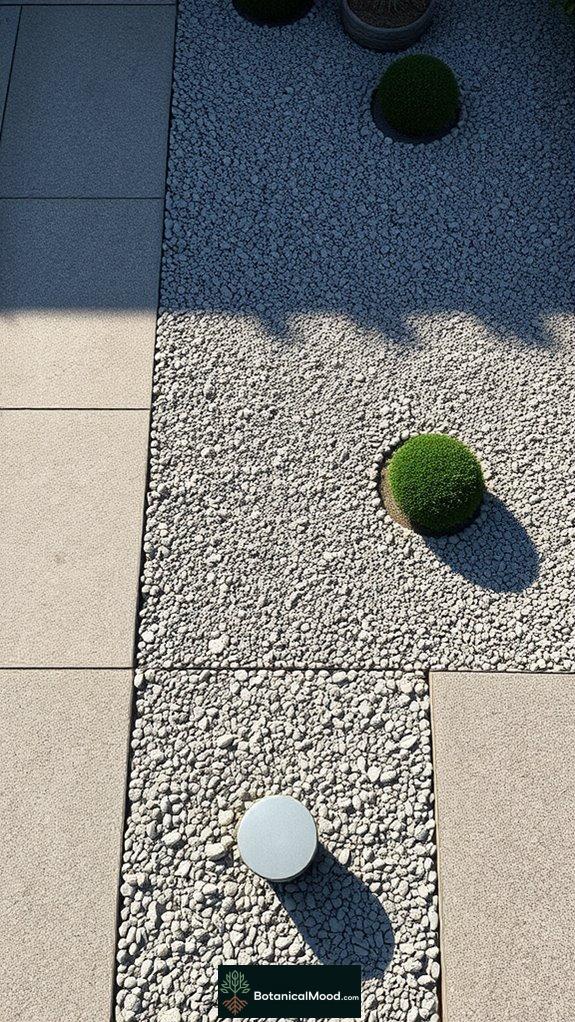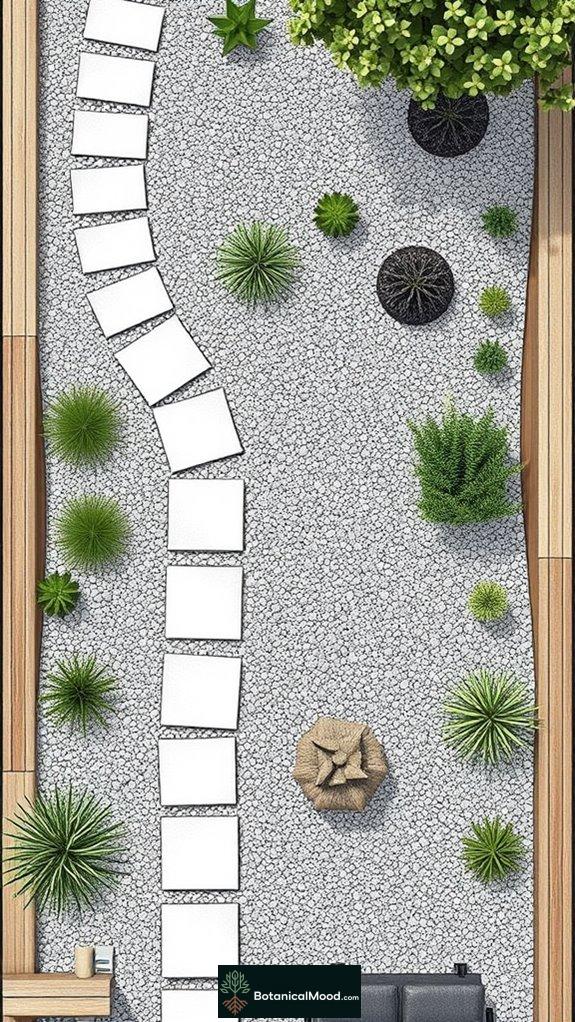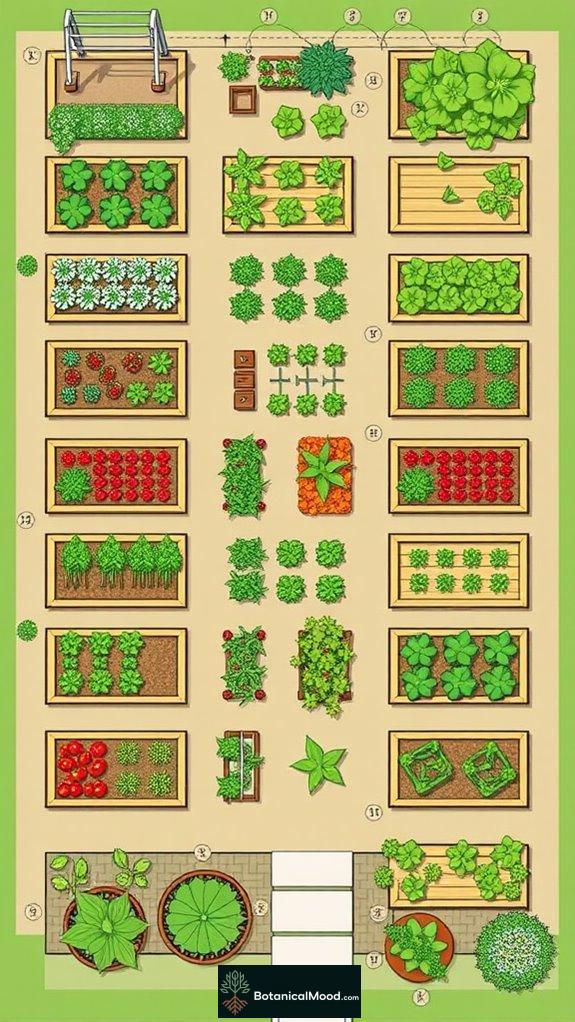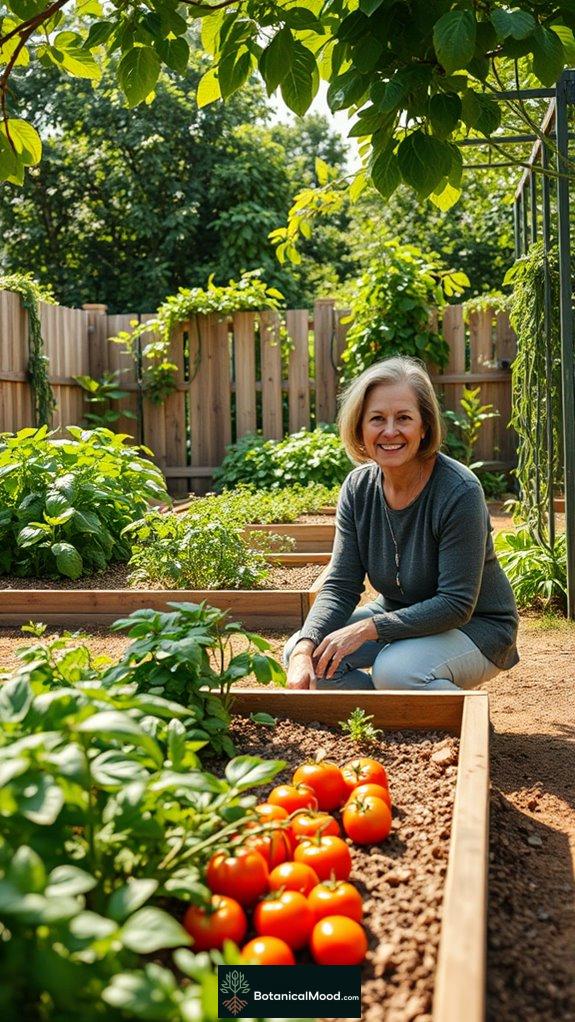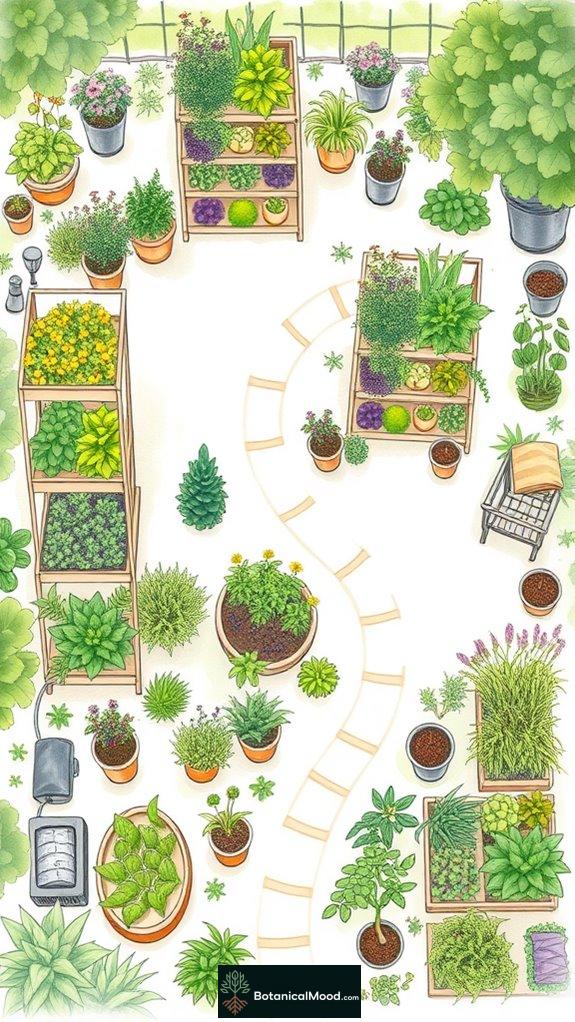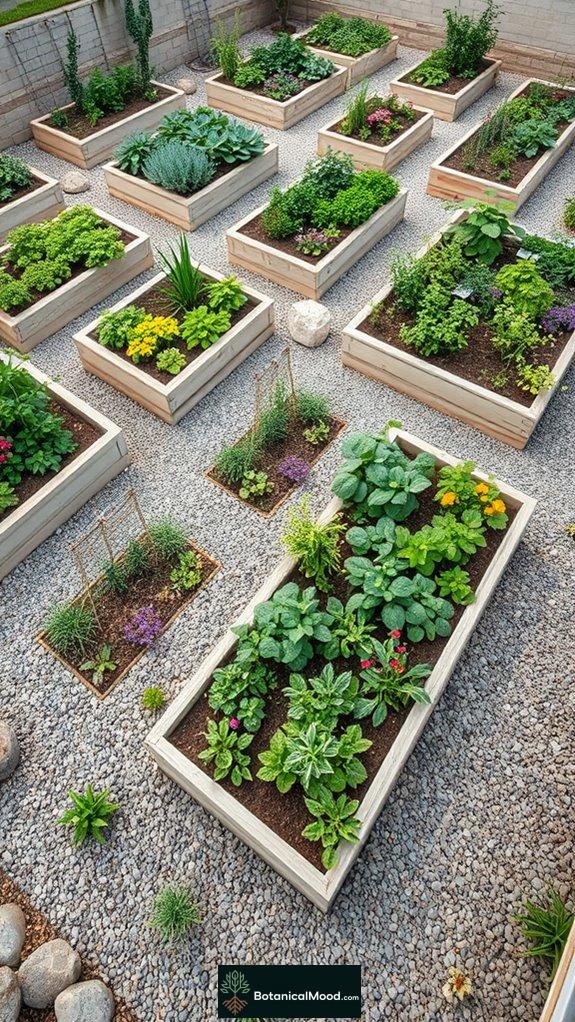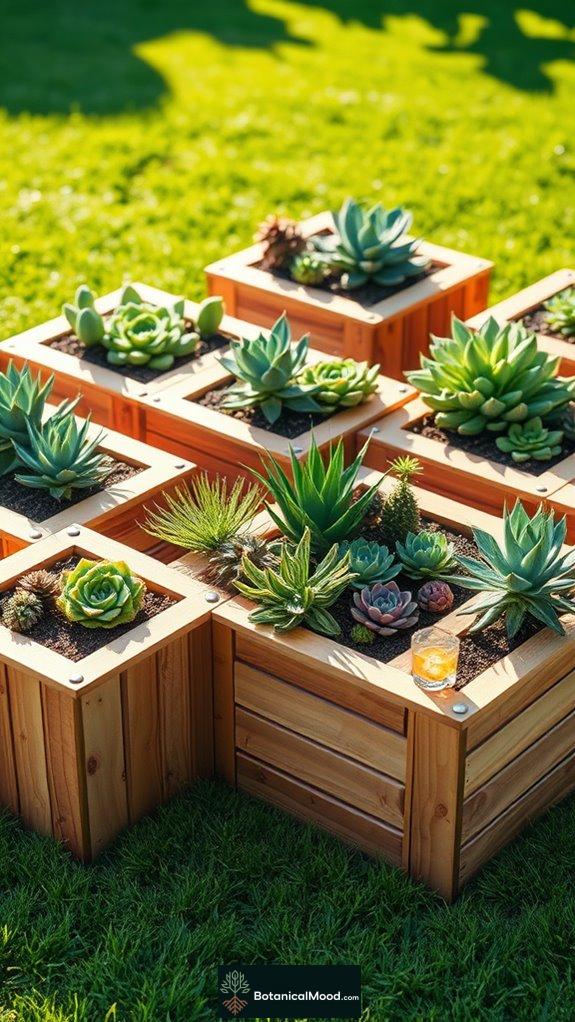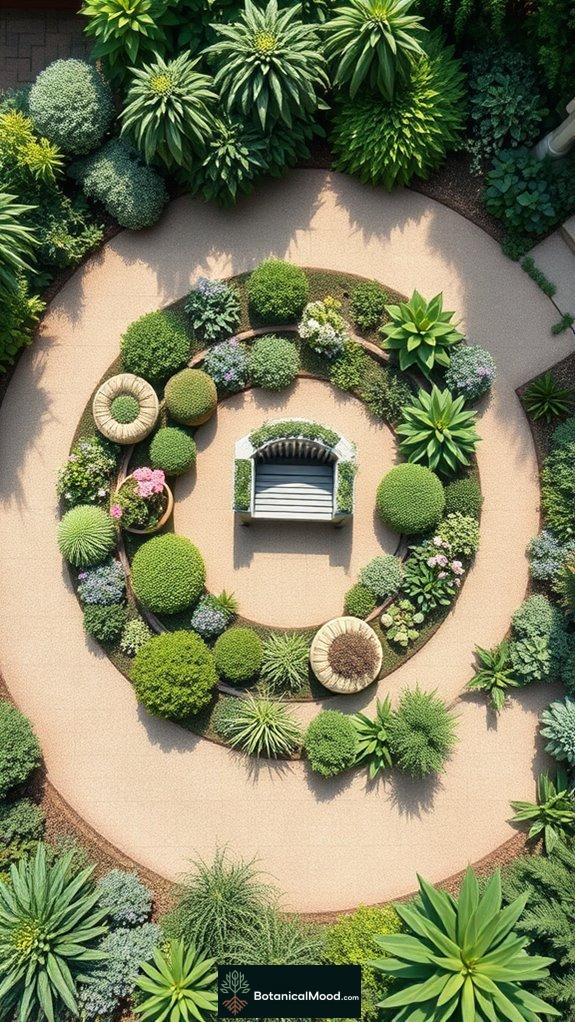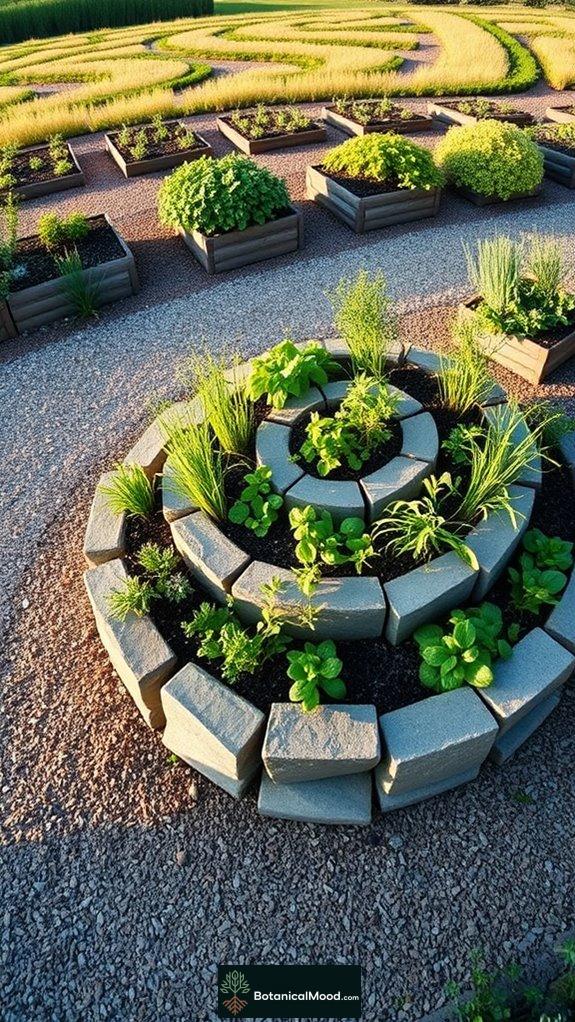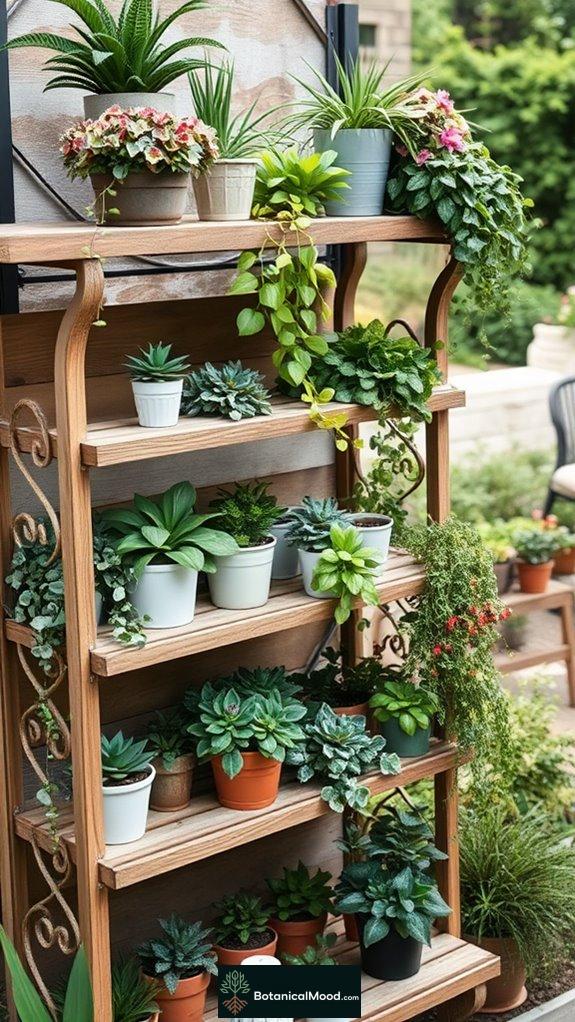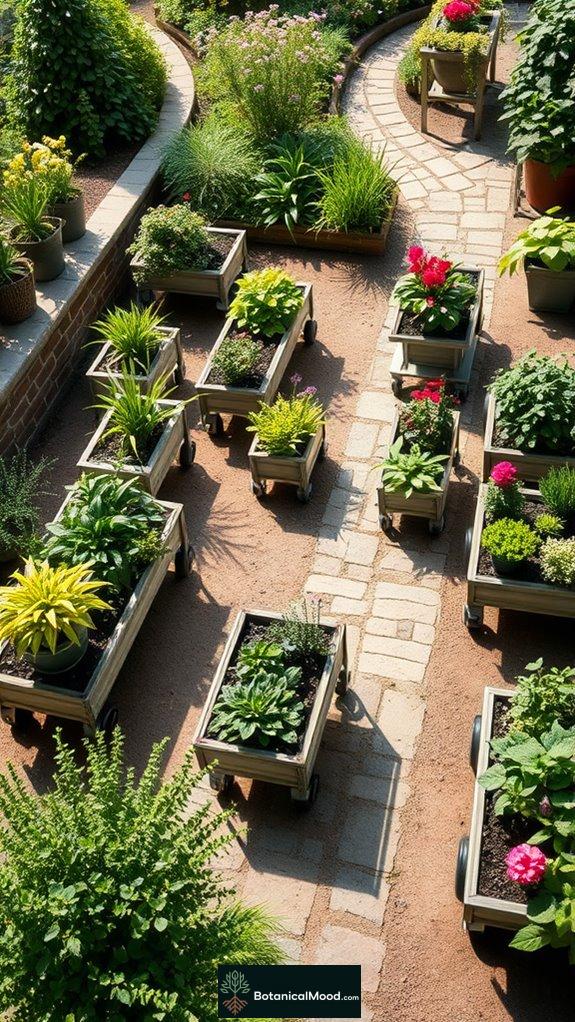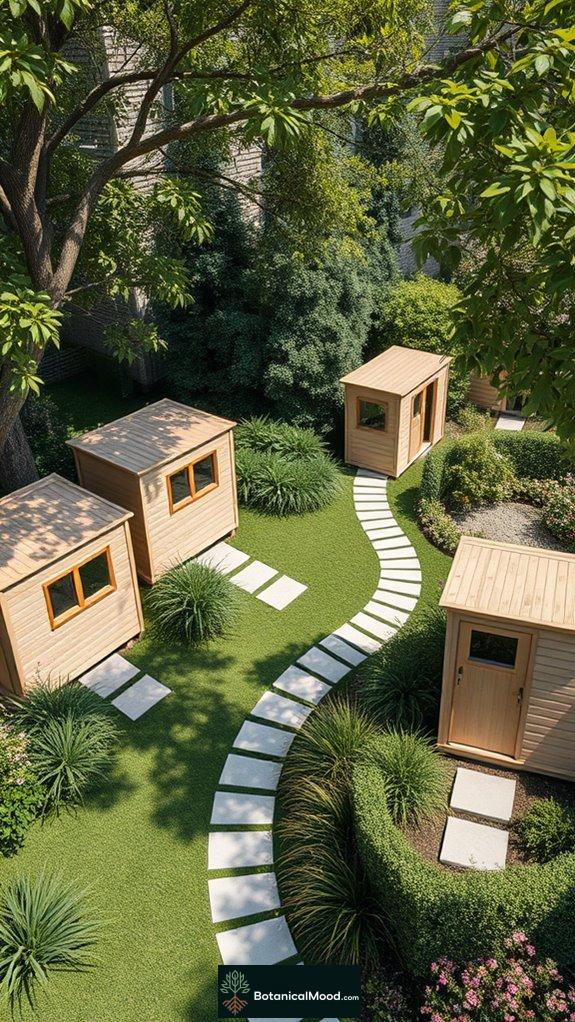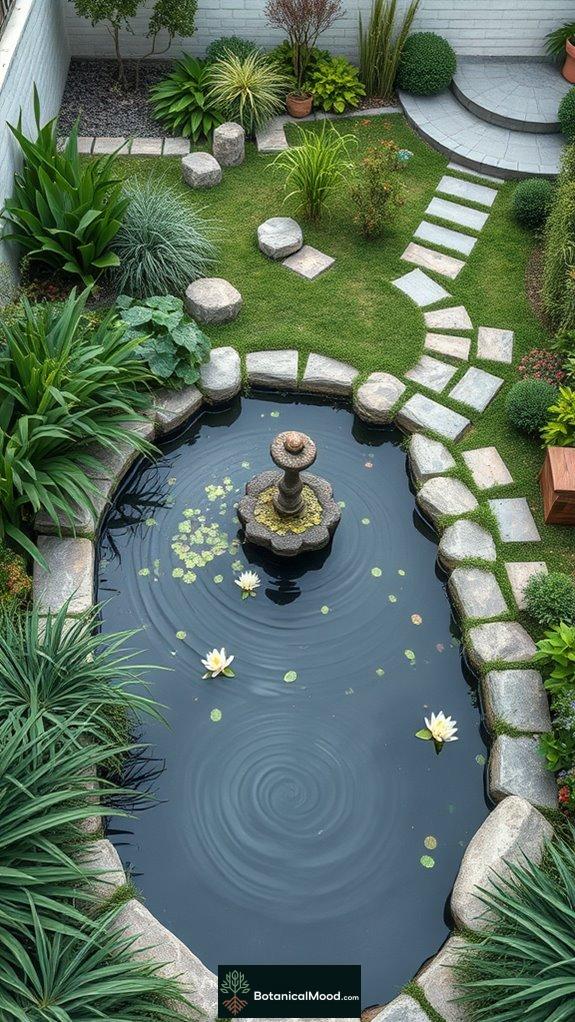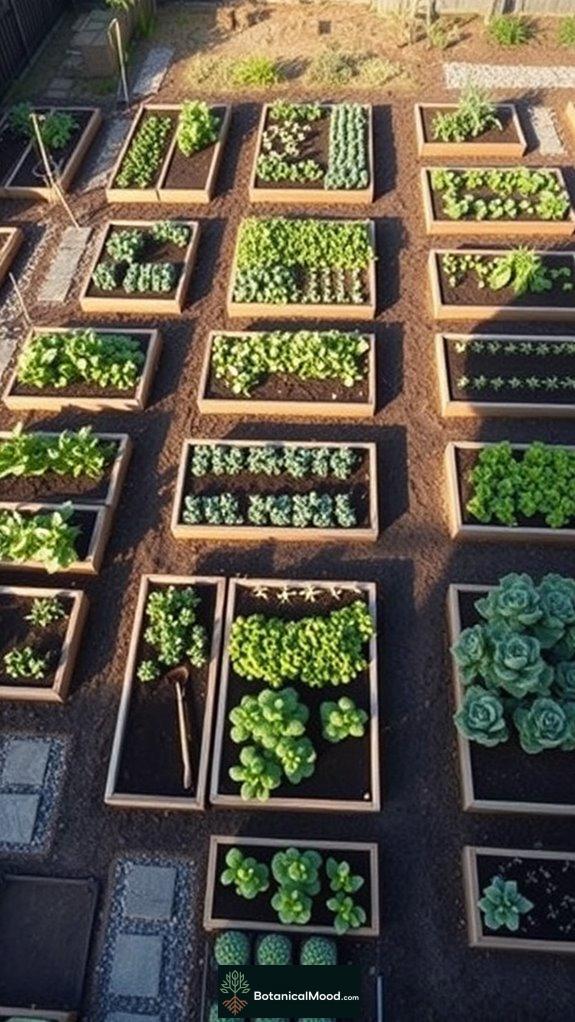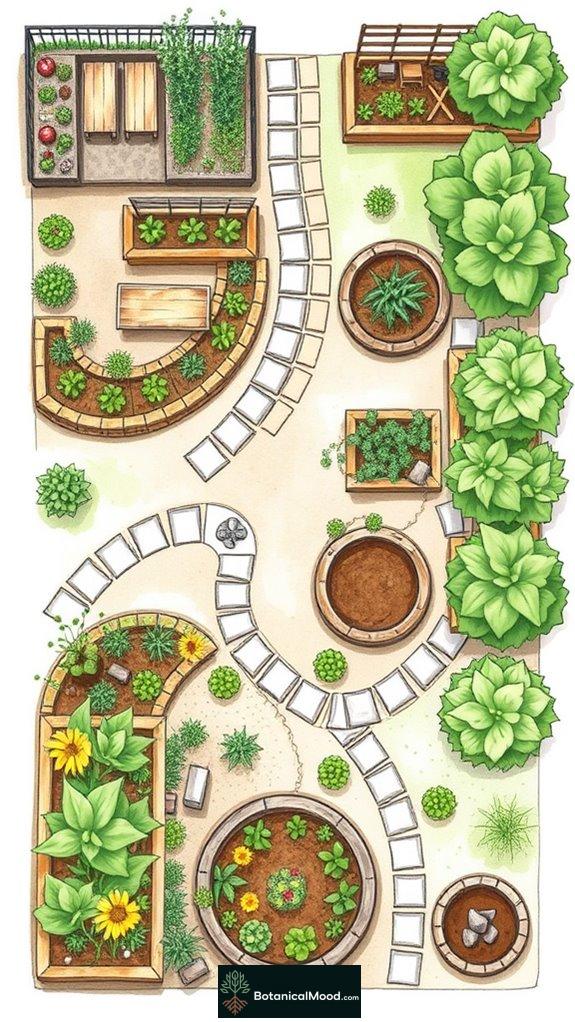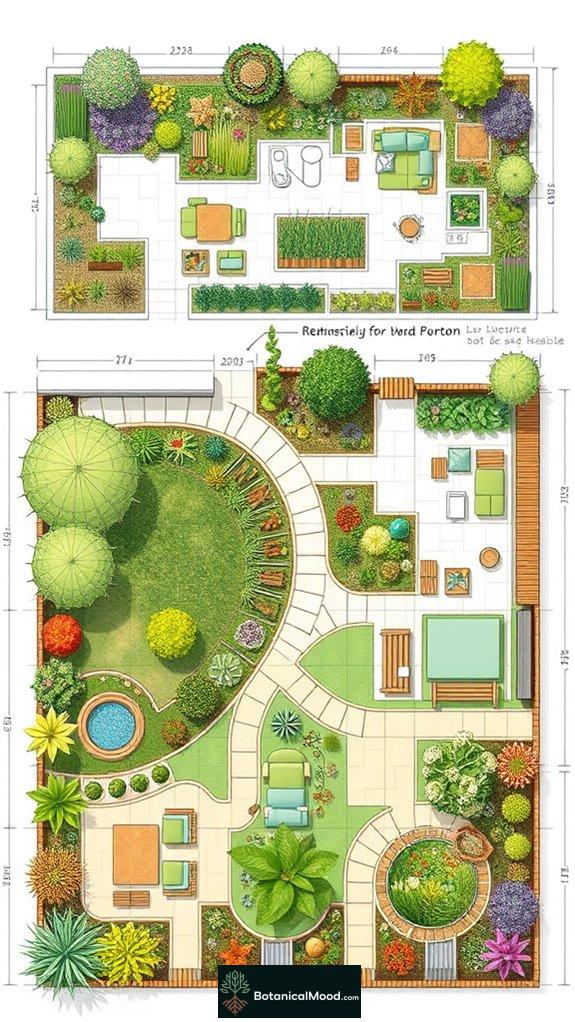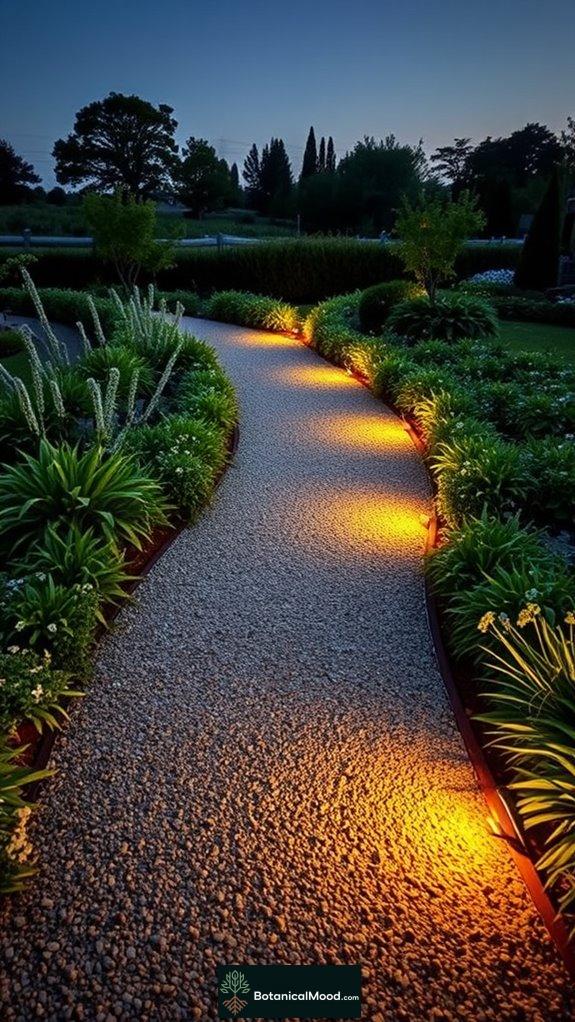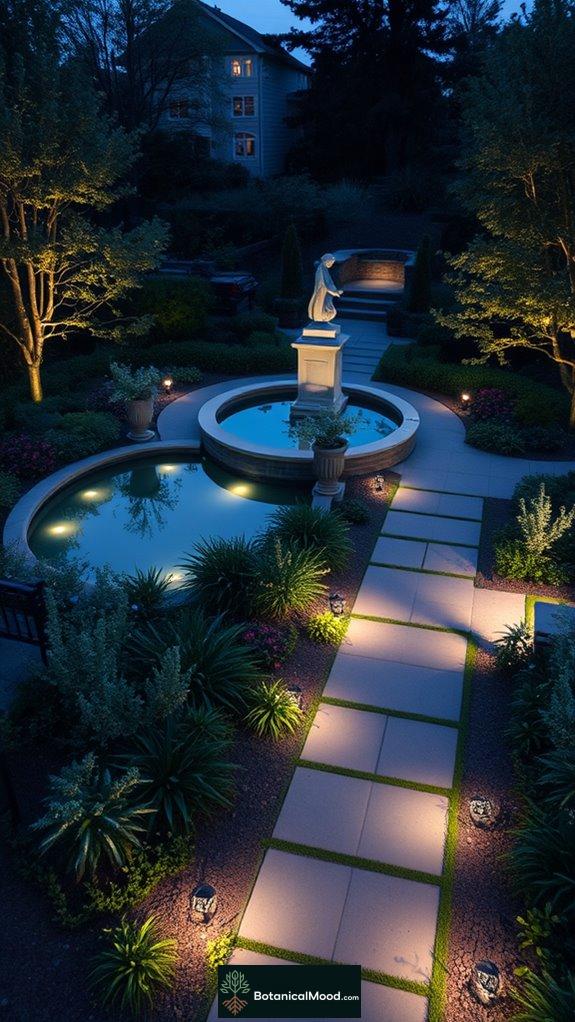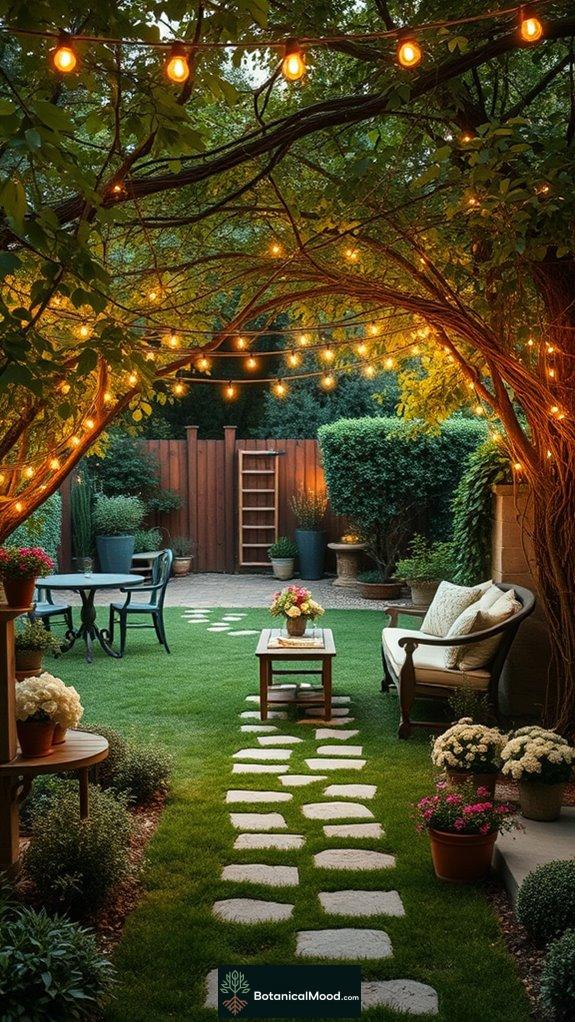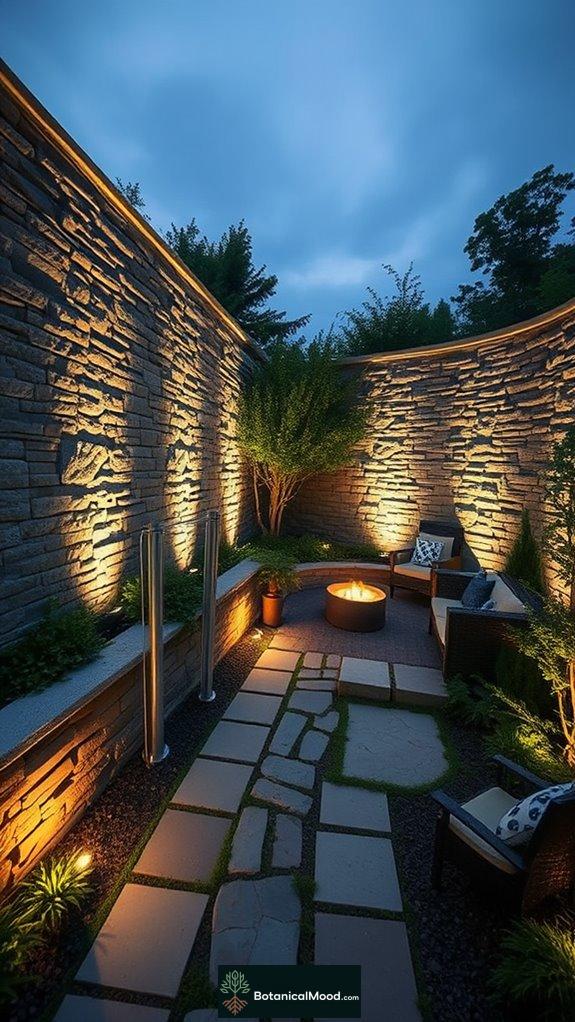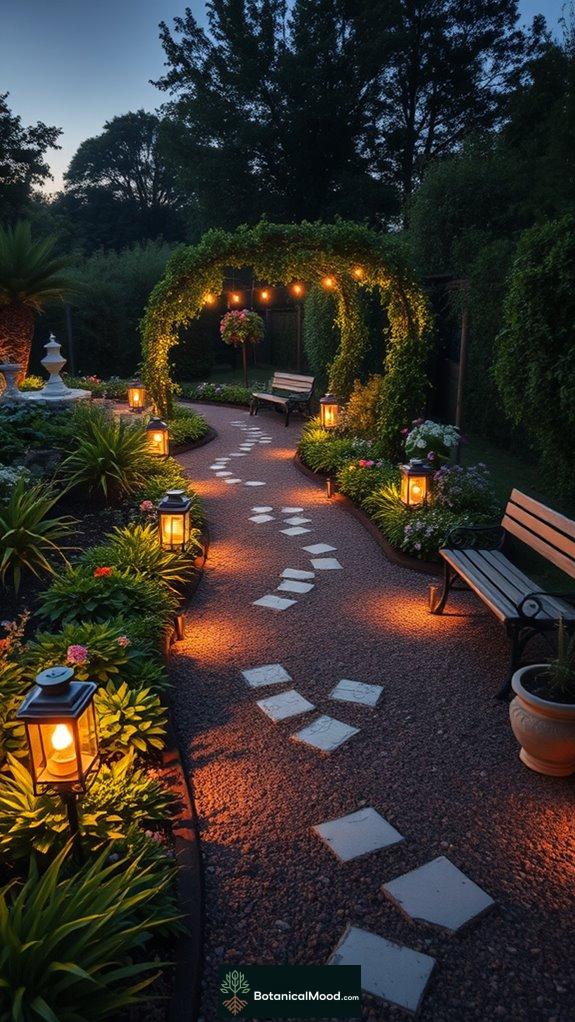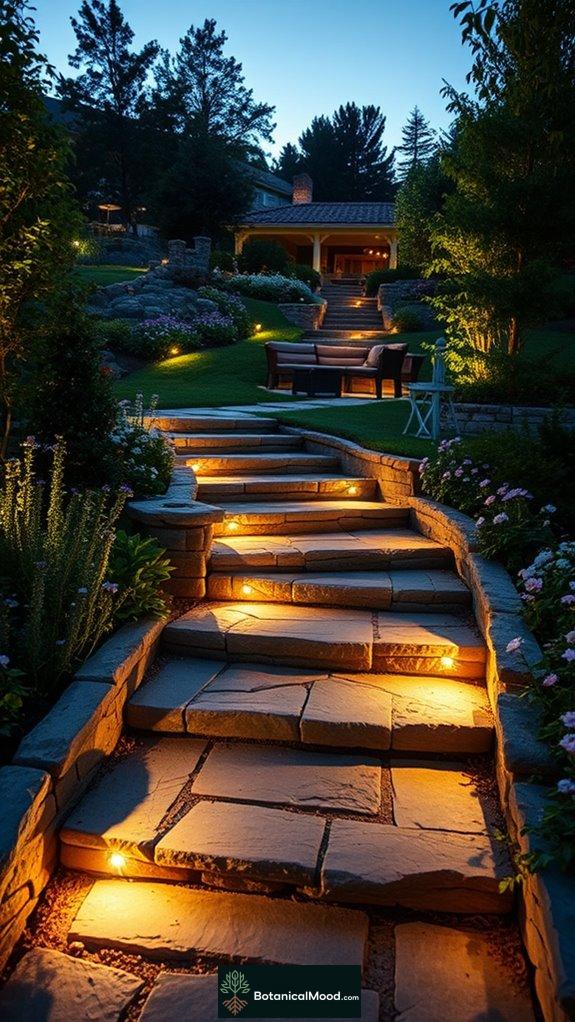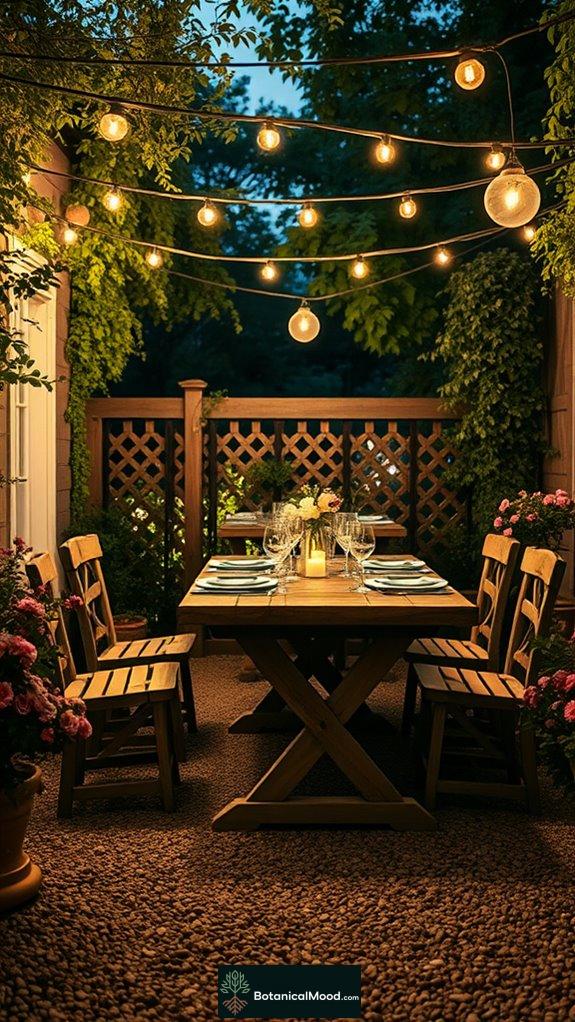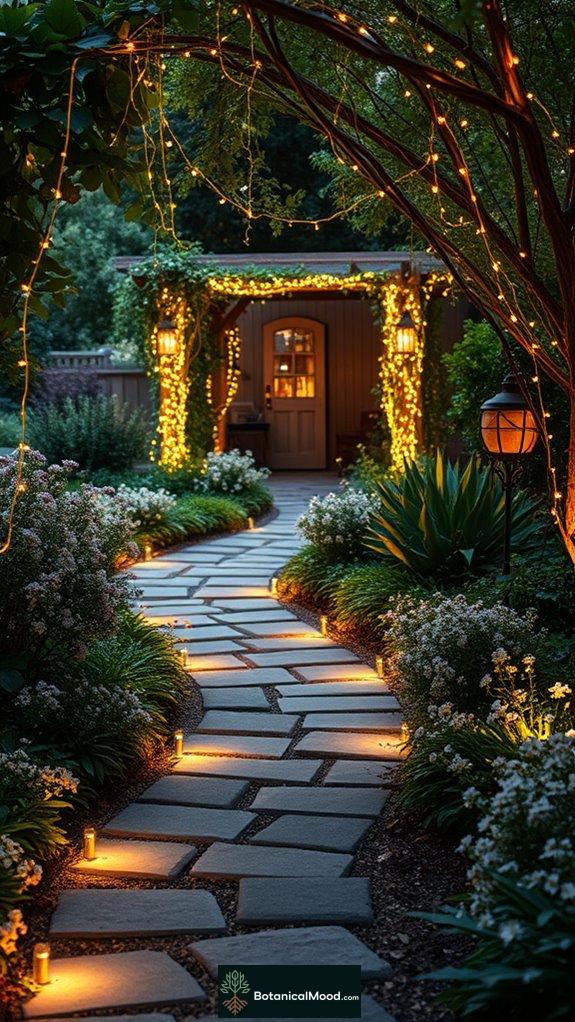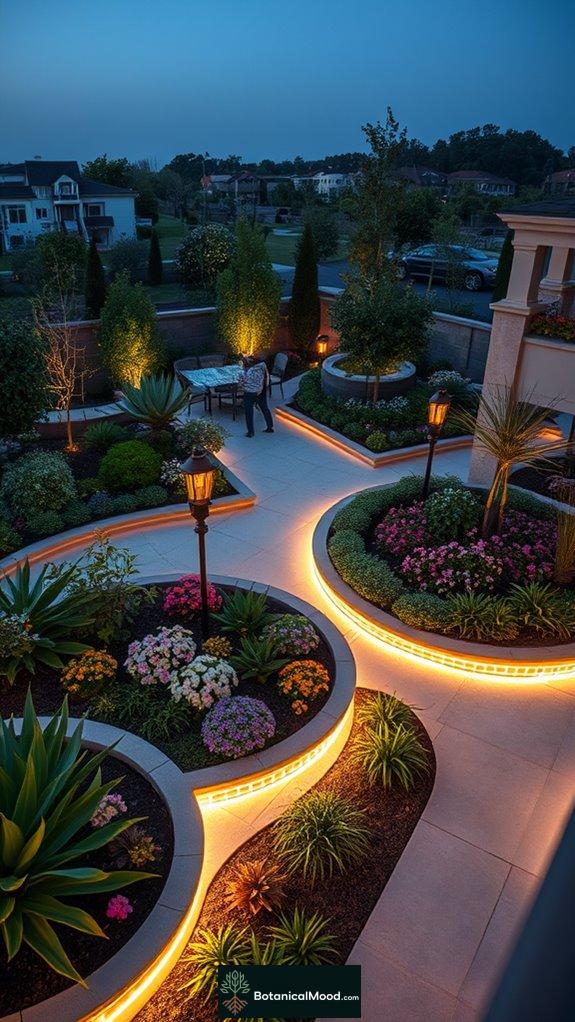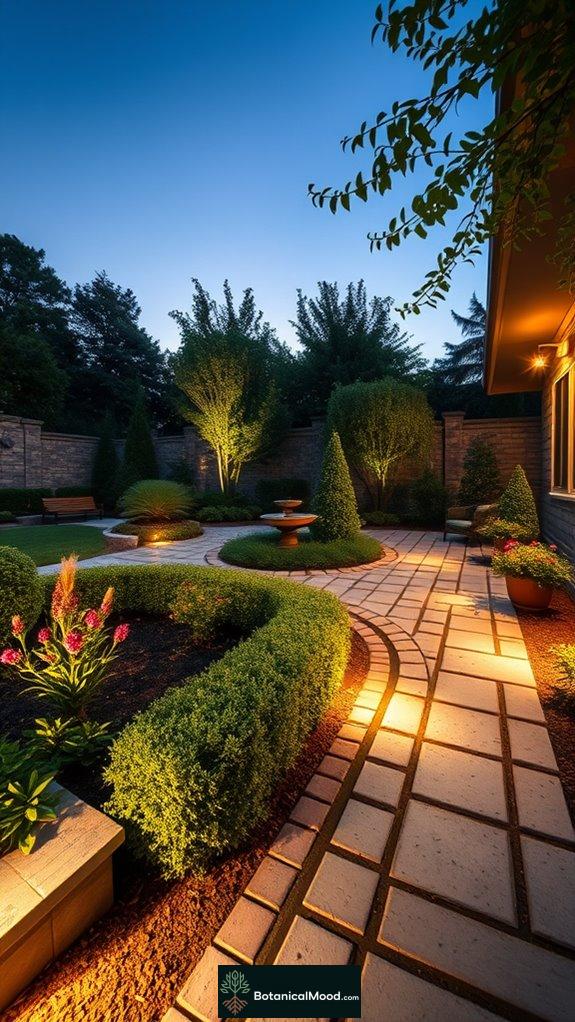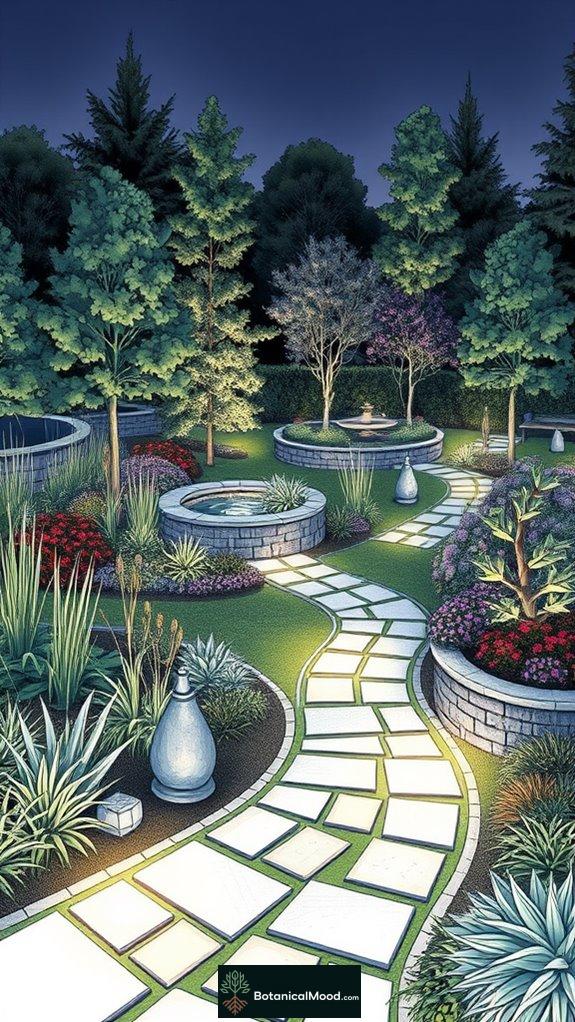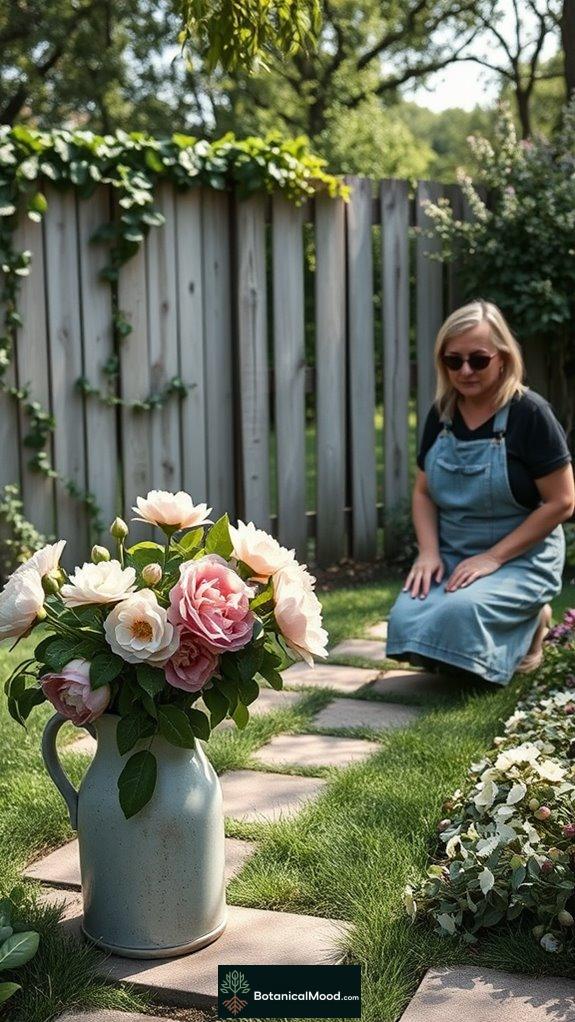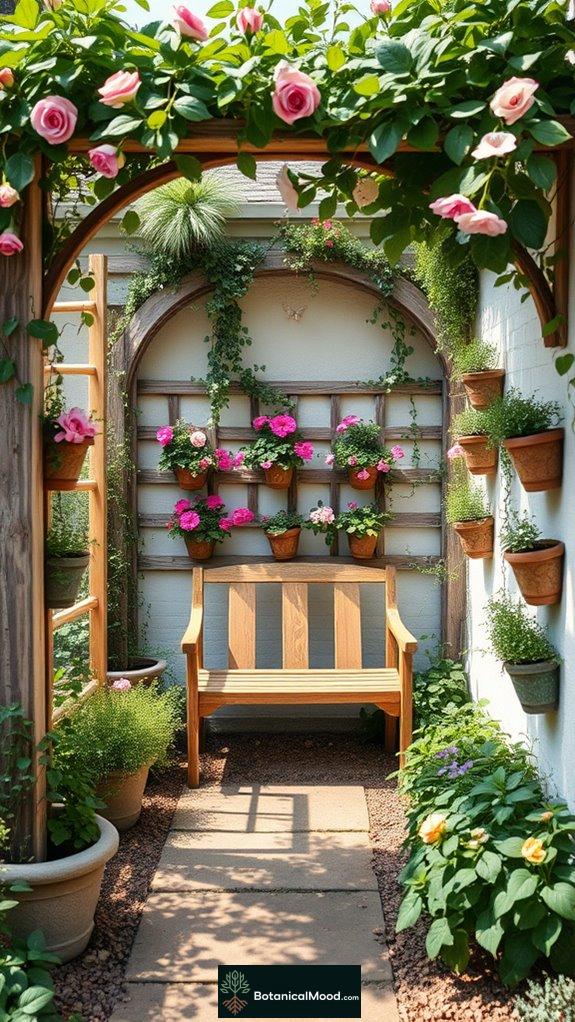Creating a woodland garden offers a unique chance to showcase lush native plants. I love utilizing layered planting techniques that arrange taller plants at the back and shorter ones upfront, enhancing visual depth. Incorporating shady nooks with cozy seating can foster tranquility. Meandering pathways invite exploration while wildlife-friendly layouts promote biodiversity. Natural rock features and distinct plant arrangements further elevate the design. There's so much to discover about artistic layouts that celebrate nature's beauty, and much more awaits you.
Quick Takeaways
- Utilize layered planting techniques to create visual depth with varying heights of native plants for a natural woodland aesthetic.
- Incorporate meandering pathways made of natural stone to enhance exploration and connect different garden areas filled with lush greenery.
- Design wildlife-friendly layouts by combining native trees, shrubs, and perennials to support biodiversity and provide essential habitats for local wildlife.
- Integrate seasonal color schemes by selecting native plants that bloom at different times, ensuring a vibrant display throughout the year.
- Create cozy seating areas using rustic materials like reclaimed wood to encourage relaxation and enjoyment in your woodland garden.
Layered Planting Techniques

When you think about designing a woodland garden, layered planting techniques can transform your outdoor space into a vibrant, living tapestry. By placing taller plants at the back and shorter ones in front, you create visual depth that draws the eye. Mixing various heights and sizes adds texture and interest, making the garden feel alive. Arranging plants in natural, irregular patterns mimics woodland environments, enhancing that intimate connection with nature. Incorporating diverse plants guarantees year-round appeal, while enriching the soil supports healthy growth. Additionally, selecting plants that are tolerant of dappled shade ensures that your garden thrives in its woodland setting. Native woodland plants provide essential habitat for local wildlife, further enhancing the ecological balance of your garden. I created Botanical Mood to inspire others to cultivate these lush, layered settings that invite exploration and reflection.
Shady Nook Designs
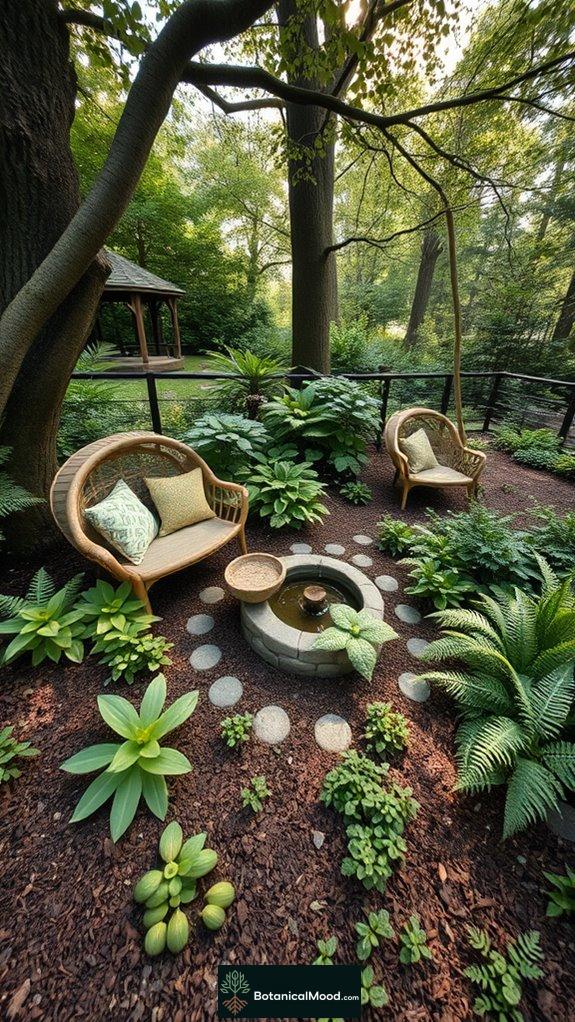
Designing a shady nook in your woodland garden can create a serene retreat, inviting relaxation and contemplation amid nature's beauty.
Here are some elements to reflect upon for your design:
- Native Plants: Choose shade-tolerant natives like ferns and hostas for biodiversity.
- Ground Covers: Use Ajuga or Lamium to suppress weeds and add texture.
- Seating Areas: Incorporate cozy seating under trees for tranquility.
- Water Features: A small fountain can enhance the soothing ambiance.
Incorporating low-maintenance plants can further simplify the upkeep of your garden, allowing you to enjoy its beauty without the burden of extensive care.
At Botanical Mood, I cherish creating spaces where nature's elegance and comfort can coexist beautifully.
Meandering Pathways

How can a winding pathway transform your woodland garden into an enchanting haven?
By creating meandering paths, you invite exploration and intimacy with nature. I love using natural stone or crushed stone paired with pine needles to mimic the forest floor. Curved designs enhance the sense of space, while gentle slopes follow the land's contours. Alongside these paths, I integrate native plants, offering vibrant colors and attracting wildlife.
Incorporating organic curved pathways not only enhances aesthetic appeal but also promotes sustainability by blending seamlessly with the environment. Soft lighting, like solar-powered lanterns, adds a magical touch for evening strolls. Each winding trail leads to new discoveries, making your garden a serene escape, just as I envisioned when creating Botanical Mood.
Naturalistic Rock Features
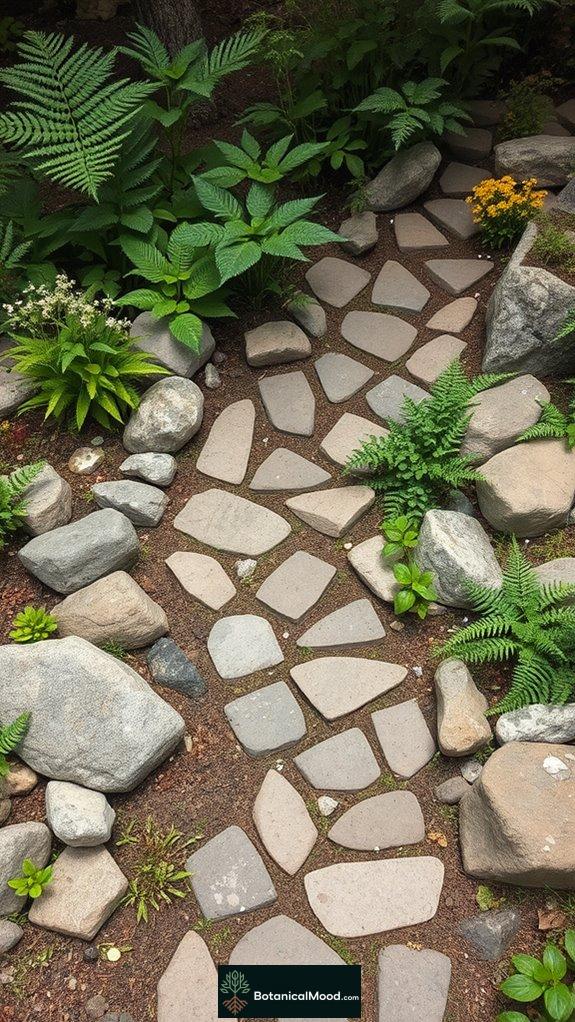
Naturalistic rock features can beautifully elevate your woodland garden, transforming it into a striking scenery that mirrors the beauty of nature. I love how the right rocks can create a harmonious blend with native plants, enhancing the garden's allure. Here are four essential tips for designing these features:
- Rock Selection: Choose local rocks for a cohesive look.
- Rock Placement: Arrange them unevenly for a natural feel.
- Visual Interest: Combine different sizes and textures.
- Erosion Control: Use rocks to stabilize slopes and prevent soil erosion.
Incorporating architectural stone features not only adds to the aesthetic but also reinforces the organic theme of your garden. Creating these designs inspired me to share my passion on Botanical Mood, helping others appreciate garden beauty.
Wildlife-Friendly Layouts
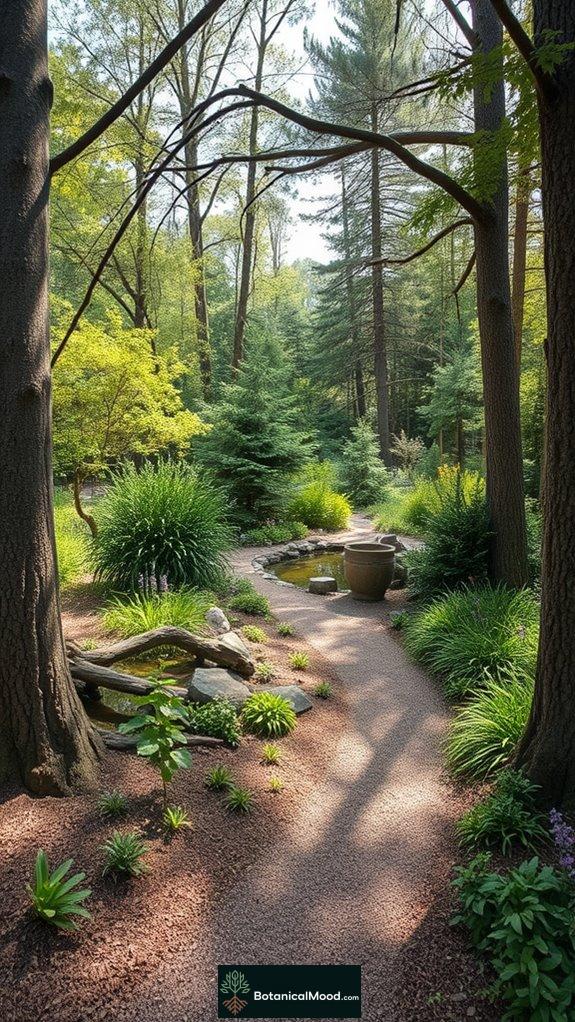
Creating a woodland garden that supports wildlife not only enhances its beauty but also fosters a thriving ecosystem. I love layering native trees, shrubs, and perennials to mimic a forest, creating diverse habitats for creatures. Choosing native plants offers essential food and shelter, while varying plant structures invites a richer biodiversity. I incorporate water features like small ponds, providing hydration for wildlife, and I leave some areas wild, allowing natural debris to nurture soil life. Additionally, selecting native plants that are specifically suited to your region can significantly improve the sustainability of your garden. These thoughtful designs not only invite nature in but also inspire me to share my passion on Botanical Mood, celebrating the harmonious blend of beauty and ecology.
Seasonal Color Schemes

As the seasons shift, a woodland garden transforms into a vibrant tapestry of colors, each phase offering its own unique charm.
I find joy in planning seasonal color schemes that breathe life into my garden all year round.
- Spring: Pale yellows and vibrant blues from primroses and forget-me-nots.
- Summer: Lush greenery and wildflowers like violets create a serene oasis.
- Autumn: Fall foliage dazzles with vibrant hues and late bloomers like asters.
- Winter: Evergreens and striking bark patterns add visual interest.
At Botanical Mood, I celebrate these seasonal wonders and their beauty in every garden. Incorporating low-maintenance native plants ensures that your garden remains easy to care for while still showcasing stunning seasonal displays.
Ground Cover Strategies
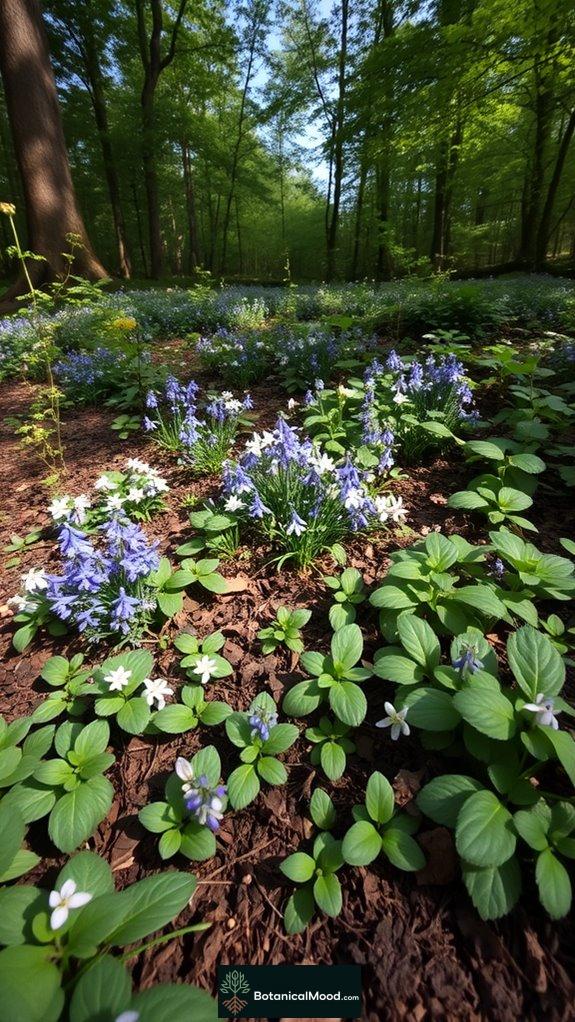
Ground cover strategies are essential for creating a lush, thriving woodland garden that not only beautifies the scenery but also supports a healthy ecosystem. Selecting native plants like Creeping Phlox, Virginia Bluebells, and Foamflower enriches both soil and biodiversity.
Here's a quick reference for some effective ground covers:
| Plant | Bloom Time | Characteristics |
|---|---|---|
| Creeping Phlox | Spring | Evergreen, fast-spreading |
| Virginia Bluebells | Early Spring | Forms large colonies |
| Foamflower | Spring | Low-spreading, creamy flowers |
| Dwarf Crested Iris | Spring | Brief blue-purple blooms |
| Bloodroot | Spring | Lasts until late summer |
Edible Woodland Gardens

When planning an edible woodland garden, it's essential to envision a space that harmonizes beauty with utility. I find joy in creating a lush environment where nature thrives alongside our culinary desires.
Here are some key principles:
- Diversity and Layering: Incorporate trees, shrubs, and groundcovers.
- Native Plant Selection: Choose plants native to your area for better ecological balance.
- Permaculture Application: Utilize sustainable methods that work with nature.
- Low Maintenance: Design gardens to thrive with minimal intervention.
At Botanical Mood, I aim to inspire you to embrace these principles for a vibrant, edible oasis. Additionally, incorporating native wisdom can enhance your understanding of how to cultivate a sustainable ecosystem within your garden.
Water Features in Woodland Settings

Incorporating water features into woodland settings not only enhances the aesthetic appeal but also creates a serene environment that invites both contemplation and wildlife.
Imagine gentle streams and soothing waterfalls, their sounds blending beautifully with the rustling leaves. Ponds and lakes offer a habitat for diverse plants and animals, enriching the ecosystem.
For smaller spaces, pondless waterfalls provide a safe yet enchanting touch. Fountains add elegance while rills create charming pathways of water. Each feature serves not just beauty, but also practical benefits, like erosion control and climate moderation.
At Botanical Mood, I cherish these designs that harmonize nature, inviting you to experience tranquility in your own garden.
Pollinator Pathways
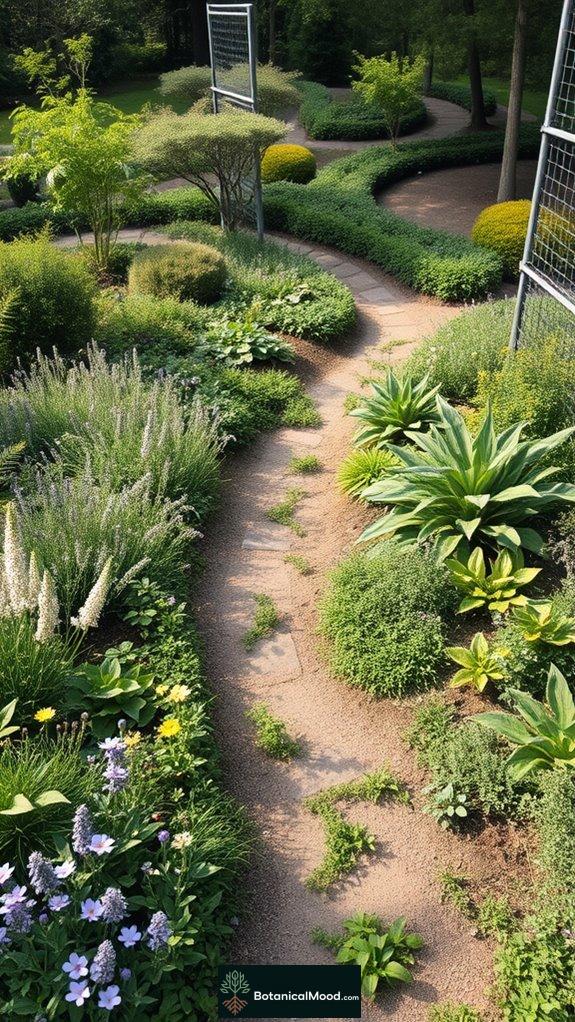
Creating vibrant corridors for pollinators through our gardens not only supports essential wildlife but also enriches the view we cherish.
By participating in this movement, we can contribute to a healthier ecosystem while enjoying the beauty of diverse blooms.
Here are four ways to enhance pollinator pathways in your garden:
- Choose Native Plants: Select species that provide food and habitat for local pollinators.
- Plan for Bloom Succession: Make sure flowers bloom throughout the seasons for continuous sustenance.
- Integrate Different Habitats: Mix trees, shrubs, and perennials to create varied environments.
- Reduce Pesticide Use: Protect our pollinator friends by choosing organic gardening practices.
Fern and Moss Combinations
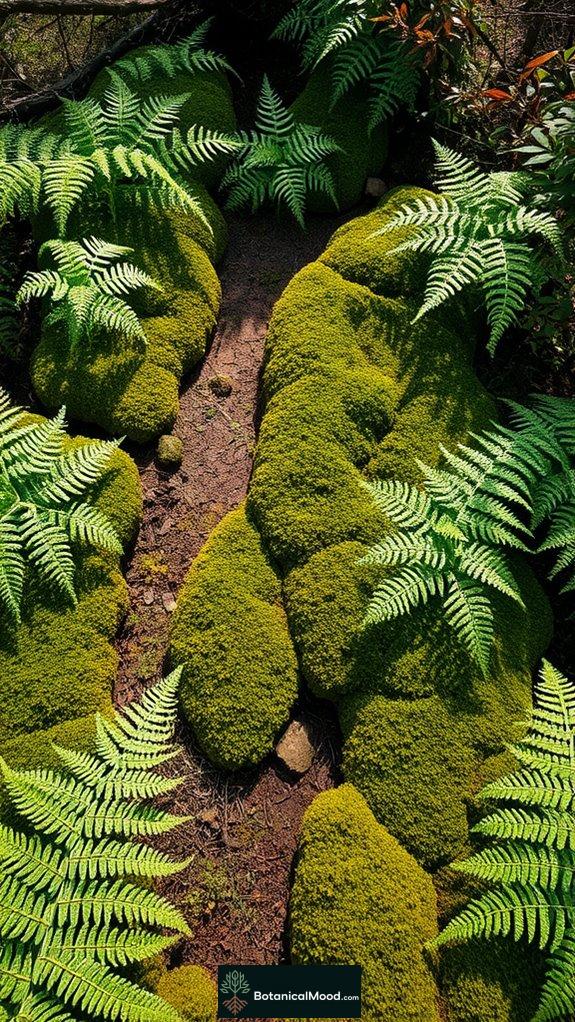
Fern and moss combinations offer a fascinating way to bring the enchanting essence of woodlands into our gardens. By carefully selecting ferns and mosses, we can create a lush, inviting atmosphere that echoes nature's beauty. Here's a simple guide to help you decide:
| Fern Species | Moss Variety | Ideal Conditions |
|---|---|---|
| Sensitive Fern | Irish Moss | Acidic, moist soil |
| Autumn Fern | Scotch Moss | Varied sun, wet soils |
| Maidenhair Fern | Fern Moss | Shady, deep moisture |
This combination nurtures a serene environment, and I created Botanical Mood to share these inspirations with you.
Rustic Seating Areas
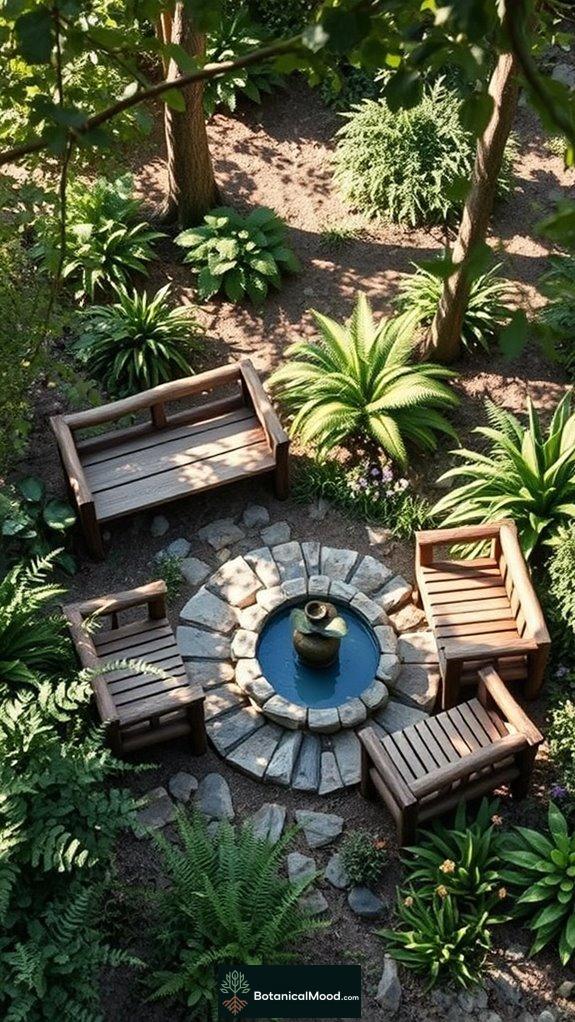
When you envision a woodland garden, the seating areas play a crucial role in enhancing the overall ambiance, making them essential for relaxation and enjoyment.
I love creating rustic seating spots that invite you to unwind and connect with nature. Here are a few ideas to reflect upon:
- Rustic benches made from reclaimed wood or stone for a timeless look.
- Log furniture that blends seamlessly into the environment.
- Modern options like sleek steel benches for a contemporary twist.
- Secluded nooks near water features, creating intimate retreats that soothe the soul.
Such spaces embody the spirit of my vision for Botanical Mood.
Native Tree Canopies

As I explore the enchanting world of woodland gardens, native tree canopies emerge as essential components that not only shape the environment but also enhance its ecological health.
Trees like oak, maple, and black walnut provide shade and support local wildlife, creating vibrant habitats. Their deep roots stabilize soil, improving drainage and reducing erosion.
I love how layered plantings of diverse tree sizes offer visual interest while ensuring lower plants receive sufficient light. Each season brings new colors, enriching our surroundings.
Through my website, Botanical Mood, I aim to inspire others to appreciate these natural wonders and create lush, sustainable gardens with native trees at their heart.
Slope Stabilization With Plants
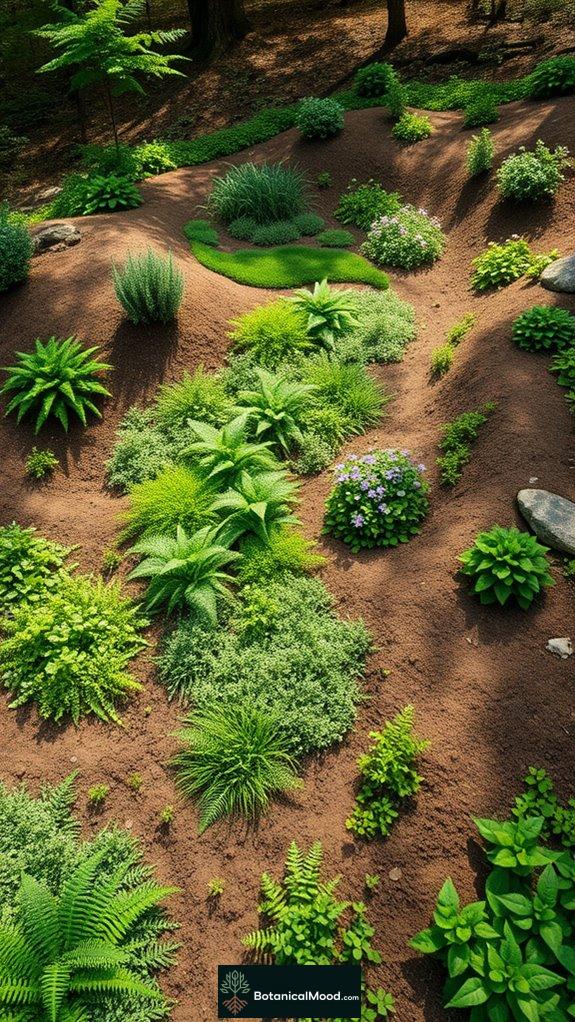
The beauty of a woodland garden isn't just found in the towering tree canopies; it extends to the slopes that support them.
I love using plants for slope stabilization, as they're both effective and beautiful. Here are some methods I find particularly helpful:
- Brush Layering: Alternating live branches with soil for stability.
- Contour Wattling: Bundling branches in trenches along slopes.
- Hydroseeding: Spraying seed mixtures for quick coverage.
- Sodding: Planting sod directly for immediate support.
In my experience, these techniques not only protect the soil but also enhance the garden's natural charm.
Integrated Garden Art
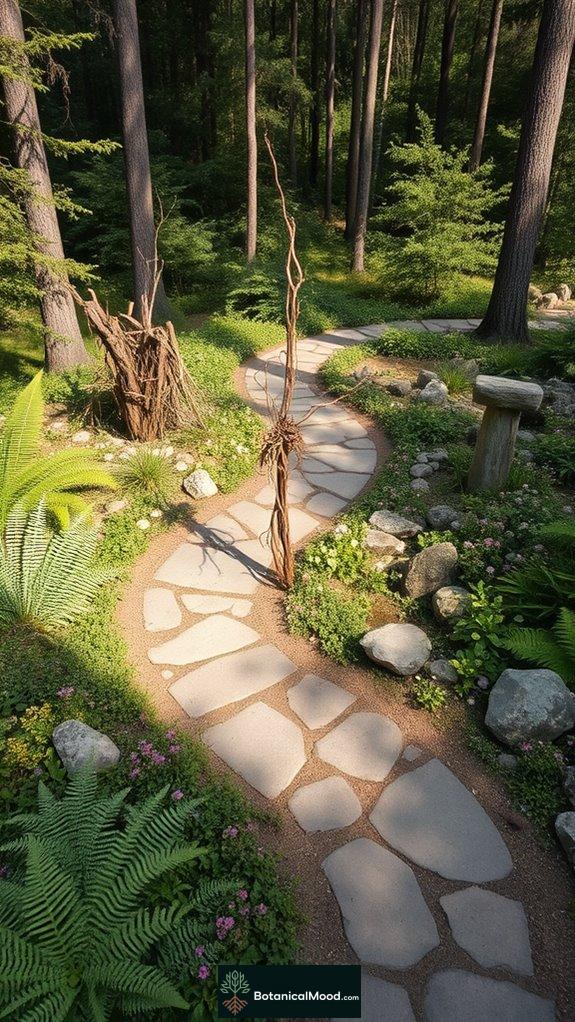
Creating a woodland garden isn't just about the plants and trees; it's also an opportunity to showcase art that harmonizes with nature. I love incorporating art pieces that reflect the colors of the surrounding flora, like vibrant sculptures against lush green leaves.
Using diverse materials, such as reclaimed wood or stone, adds texture and depth. I often choose eco-friendly art to minimize my impact, supporting local artists in the process.
Decorative planters and whimsical twig sculptures serve as focal points, inviting visitors to explore. This integration of art transforms a simple garden into a beautiful, engaging space.
Educational Nature Trails
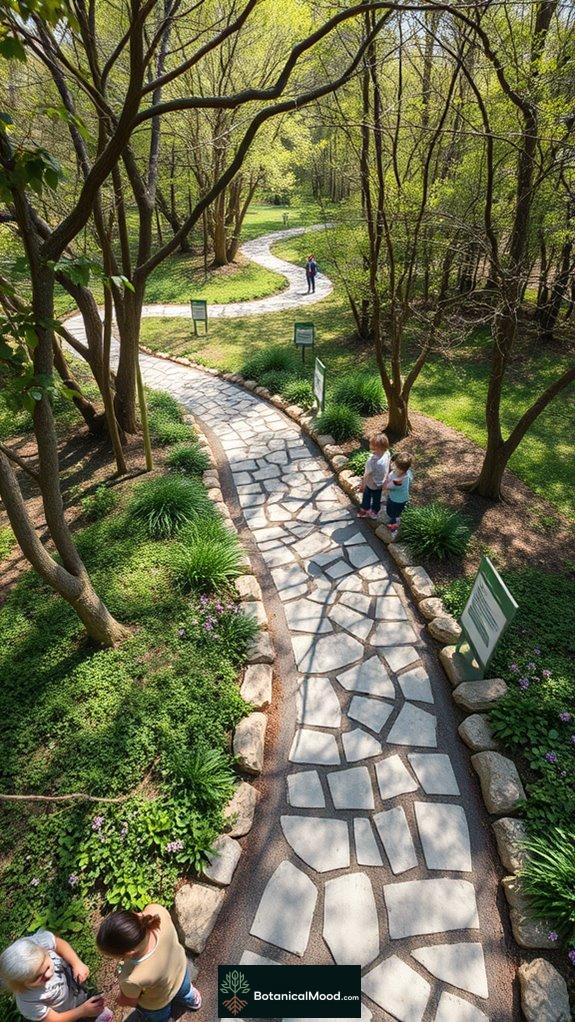
Educational nature trails offer a unique way to explore the beauty of our natural environments while learning about the ecosystems that thrive within them.
These trails not only connect us with nature but also foster a sense of responsibility for our surroundings.
Here are some key features I adore:
- Informative signage about local flora and fauna.
- Hands-on activities that engage visitors of all ages.
- Opportunities for citizen science projects.
- Accessible designs that invite everyone to participate.
I created Botanical Mood to share this intimacy with nature, helping you discover the wonders of educational trails in our woodland gardens.
Natural Habitat Garden Layouts

Natural habitat garden layouts offer an incredible opportunity to create spaces that not only enhance the beauty of our surroundings but also support local wildlife.
Woodland Plant Arrangement Techniques
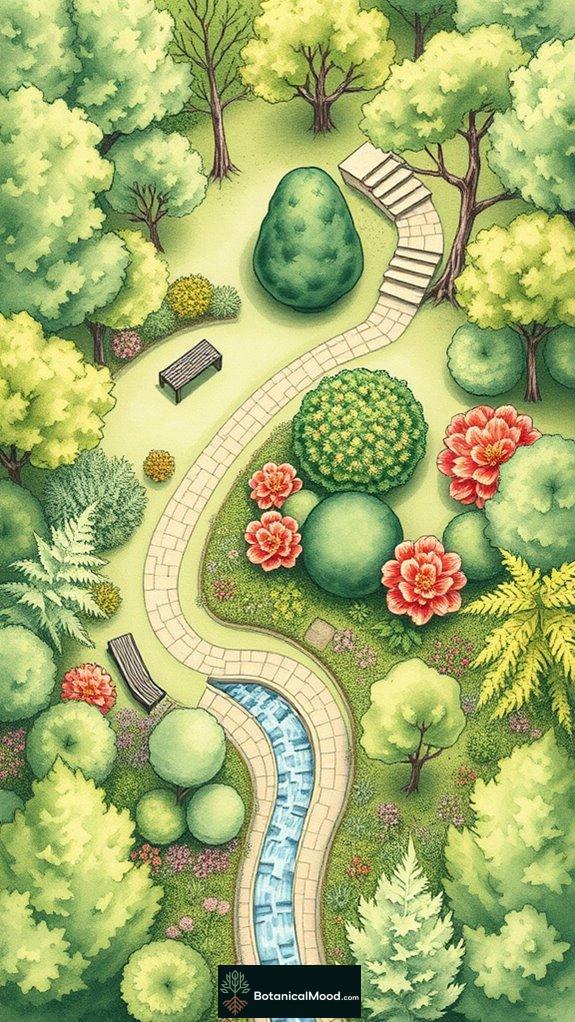
When planning a woodland garden, it's essential to contemplate how you'll arrange your plants to create a harmonious and layered effect.
I find these techniques invaluable:
- Canopy Layer: Start with tall trees like oak or maple for height.
- Understory Layer: Add mid-level trees, such as dogwoods, to offer depth.
- Shrub Layer: Incorporate flowering shrubs like camellias for bursts of color.
- Groundcover Layer: Finish with ferns and wildflowers to form a lush base.
These strategies not only enhance beauty but also foster an ecosystem, reminding me why I created Botanical Mood—to celebrate nature's artistry.
Woodland Planting Scheme Design

Creating a woodland planting scheme goes beyond just placing plants in the ground; it's about crafting a living tapestry that nourishes both the eye and the ecosystem.
I love selecting native plants that not only thrive but also enhance biodiversity. Rich, well-draining soil is essential, as is choosing plants with multi-seasonal interest. By mixing textures and layers, I create visual depth.
Informal pathways of natural materials invite exploration, while elements like rustic seating add comfort. Each choice I make is deliberate, ensuring the garden feels both intimate and inviting, reflecting the beauty I envision on Botanical Mood.
Together, we can celebrate nature's artistry.
Creating Functional Plant Zones
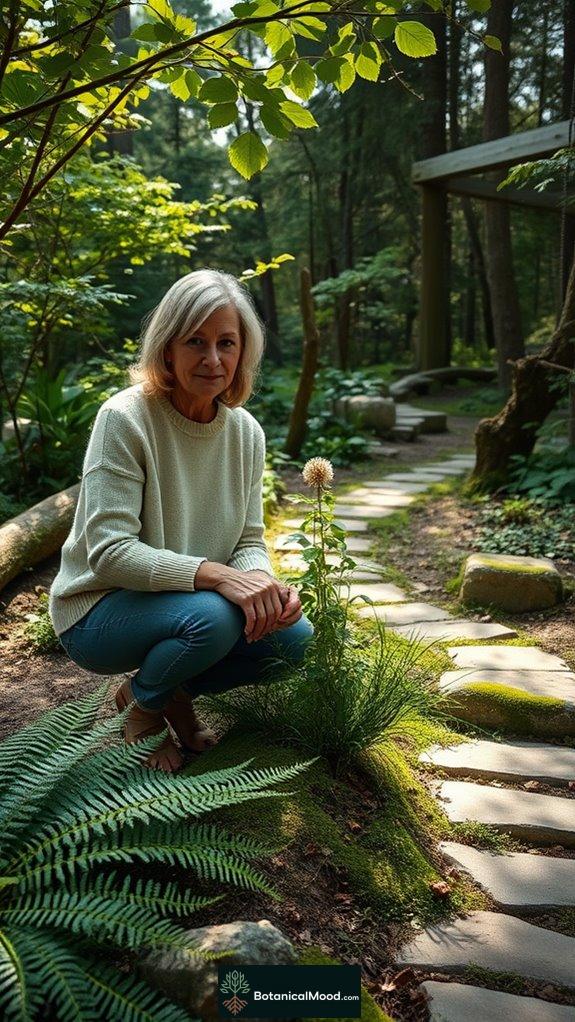
In a woodland garden, functional plant zones come alive through thoughtful organization, where each layer harmonizes to create a vibrant ecosystem.
To create these zones, consider the following:
- Tall Trees: Establish a canopy with mature trees like oaks.
- Understory Trees: Add species like dogwood for complexity and biodiversity.
- Shrubs and Perennials: Incorporate elderberry and ferns to thrive in partial shade.
- Ground Covers: Use wild geranium to prevent soil erosion and maintain moisture.
I designed Botanical Mood to share my passion for these lush native plants, helping you cultivate your own enchanting woodland space.
References
- https://www.youtube.com/watch?v=kno5MTPvWGw
- https://www.gardendesign.com/landscape-design/woodland-garden.html
- https://www.finegardening.com/article/designing-in-layers
- https://gardengoodsdirect.com/blogs/news/creating-a-woodland-garden-using-native-plants
- https://www.monrovia.com/be-inspired/design-a-lush-woodland-garden.html
- https://www.americanmeadows.com/product/pre-planned-gardens/shade-loving-garden-small
- https://www.monrovia.com/be-inspired/shade-garden-design-tips-and-plants.html
- https://www.jacksonandperkins.com/blog/garden-blogs/five-woodland-garden-ideas/b/woodland-garden-ideas/
- https://www.pinterest.com/tuscansun66/shady-nooks-and-garden-spaces/
- https://landscapedesignsai.com/garden-ideas/woodland-garden-path-ideas


